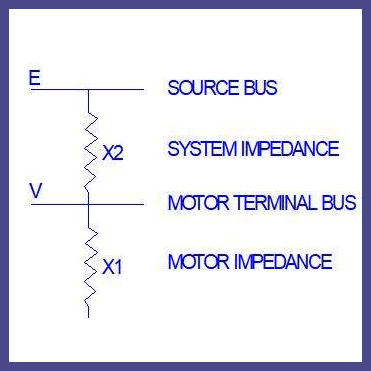3T - Introduction to Motor Starting Analysis
The starting current of most AC motors is several times normal full load current. Both synchronous and induction motors can draw five to ten times full load current when starting them across the line. Motor-starting torque varies directly as the square of the applied voltage. If the terminal voltage drop is excessive, the motor may not have enough starting torque to accelerate up to running speed. Running motors may stall from excessive voltage drops, or under-voltage relays may operate. In addition, if the motors are started frequently, the voltage dip at the source may cause objectionable flicker in the lighting system.
Description:
The starting current of most AC motors is several times normal full load current. Both synchronous and induction motors can draw five to ten times full load current when starting them across the line. Motor-starting torque varies directly as the square of the applied voltage. If the terminal voltage drop is excessive, the motor may not have enough starting torque to accelerate up to running speed. Running motors may stall from excessive voltage drops, or under-voltage relays may operate. In addition, if the motors are started frequently, the voltage dip at the source may cause objectionable flicker in the lighting system.
By using motor-starting study techniques, these problems can be predicted before the installation of the motor. If a starting device is needed, its characteristics and ratings can be easily determined. A typical digital computer program will calculate speed, slip, electrical output torque, load current, and terminal voltage data at discrete time intervals from locked rotor to full load speed. Also, voltage at important locations throughout the system during start-up can be monitored. The study can help select the best method of starting, the proper motor design, or the required system design for minimizing the impact of motor starting on the entire system.
The material in this course is presented with numerous diagrams, waveforms to help students understand how large motors are started in large industrial systems.
| Learning Objectives | In Introduction to Motor Starting Analysis course, you'll learn...
|
|---|---|
| CEU/PDH | 0.3 CEU / 3 PDH |
| Language | English |
Custom Tab Content
At vero eos et accusamus et iusto odio dignissimos ducimus qui blanditiis praesentium voluptatum deleniti atque corrupti quos dolores et quas molestias excepturi sint occaecati cupiditate non provident,
- Similique sunt in culpa qui officia deserunt mollitia animi.
- Nam libero tempore cum soluta nobis est.
- Itaque earum rerum hic tenetur a sapiente delectus ut aut reiciendis.
Custom Tab Content
Sed ut perspiciatis unde omnis iste natus error sit voluptatem accusantium doloremque laudantium, totam rem aperiam, eaque ipsa quae ab illo inventore veritatis et quasi architecto beatae vitae dicta sunt explicabo.
Nemo enim ipsam voluptatem quia voluptas sit aspernatur aut odit aut fugit, sed quia consequuntur magni dolores eos qui ratione voluptatem sequi nesciunt.




Validate your login
Sign In
Create New Account